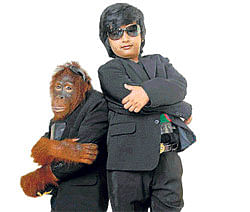Animals under spotlight

The trend of using animals in movies goes a long way back. Who can forget the old Rajesh Khanna number from Haathi Mere Saathi or the ever faithful Lassie, the dog, in the English movie series Lassie? If actors made their mark with their performances, so did various animals who donned full-fledged roles in movies.
Sandalwood too has had its share of animals in their films, be it the elephant in the Prabhakar starrer Khiladi Thata, the horse in Ashvamedha, or the orang-utan in the yet to be released Appu Pappu. “Animals are a huge part of the society. And when we make films about everyday life, we can’t ignore them. Using animals gives the film a more realistic feel,” says Chandru, the director of Mylari, in which a ram is being used.
Earlier in Sandalwood, using animals in the form of mythological characters, was a common trend. Some actors even played the role of animals in such films. For example, Jayamala was seen as a mermaid in Babruvahana. Later on, the trend changed. Real animals were used in small roles in children’s films. Like in films starring Baby Shamili. In Puttani Agent, a monkey and a dog were seen assisting the child actors to beat up the bad guy. If not in full-fledged roles, many movies use animals like donkeys and monkeys in comedy sequences.
For actors, sharing screen space with animals is a great feeling. Karthik, who is sharing screen space with a dog and a horse in his upcoming movie Karthik, says, “It’s very important for an actor to be familiar with the animal. I have been a polo player and literally grew up with horses. One has to be patient and should be an animal lover. As an actor, don’t force anything on the animal. Give it time to adjust to the surroundings, the camera and you. Though horses are loving animals, they can be tough at times and very moody as well. On the sets, we have to make sure that they have been taken care of. I was very attached to the animal and would take carrots for him to eat.”
Gradually, due to strict rules and regulations from animal rights organisations and the animal husbandry department, many film-makers try and avoid using animals in films. Says Rukhsana, an animal rights activist, “There is no guarantee that the animals used in these movies are treated properly. They may get overworked and may not be fed properly. Hence the rules are made strict so that the film-maker provides the required documents ensuring that the animal is safe,” she adds.
Using an animal in a film means the film-makers will have to have an on-call veterinary doctor on the sets who will certify and maintain the animal’s good health through the shoot. Also, the makers will have to get the animal registered in the animal husbandry department and get a certificate stating that everything went on well. It does not stop there, director Sumana Kittur says, “Even if there is a crow flying in the background, we have to get a certificate stating that a crow was used. This certificate, along with the scenes where the animal is seen, is then sent to the Central Government who will then clear it for post-production. This alone takes a good 15 days, causing a huge waste of time and production cost.”
Says actor Shivarajkumar, who has shared screen space with many animals including a crocodile and now with a ram in Mylari, “The rules are too strict especially for film-makers. One understands that the animal must not be ill-treated on the sets but the rules, at times, take it too far. Ill-treatment of animals don’t happen only on film sets, what about those which are run over? We see so many snakes and dogs getting run over on the roads and the animal activists don’t go running behind them? It’s time they loosen up the rules a bit,” he states.
Wild act
Films that have animals in them
*‘Nagamandala’ — Snake
*‘Hollywood’ — Monkey
*‘Khiladi Thata’ — Elephant
*‘Nagarahole’ — Dog
*‘Mylari’ — Ram
*‘Appu Pappu’ — Orang-utan
*‘Karthik’ - A horse and a dog